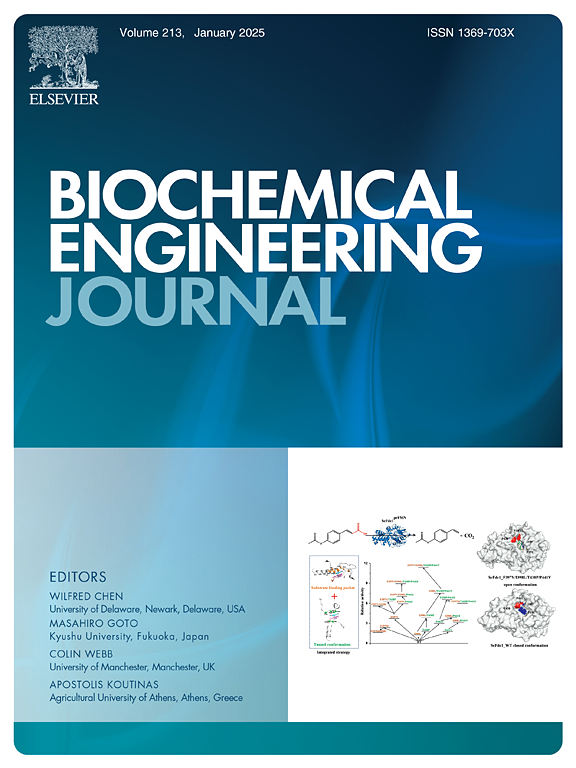Enhanced polyhydroxybutyrate production from biomass using engineered Halomonas sp. YLGW01 with improved xylose metabolism
IF 3.7
3区 生物学
Q2 BIOTECHNOLOGY & APPLIED MICROBIOLOGY
引用次数: 0
Abstract
Polyhydroxybutyrate (PHB) is a biodegradable polymer that can be accumulated by microorganisms as a carbon and energy storage compound. PHB is an attractive alternative to petroleum-based plastics for sustainable bioplastic production. Utilizing lignocellulosic biomass for PHB production provides environmental, economic, and sustainable benefits. Therefore, developing a strain capable of utilizing all sugars derived from lignocellulosic biomass is a practical strategy for efficient microbial production of PHB. In this study, xylose metabolism-related genes were introduced into the PHB-producing Halomonas sp. YLGW01 strain to enable PHB production from xylose. The introduction of xylose isomerase (xylA) and xylulokinase (xylB) enhanced xylose metabolism in Halomonas sp. YLGW01. Optimizing the medium composition, including xylose concentration, nitrogen source, and yeast extract concentration, resulted in a PHB titer of 0.73 g/L. The engineered strain exhibited high dry cell weight (DCW) and PHB production from xylose alone and from mixed sugars, including sucrose and glucose. Furthermore, lignocellulosic biomass hydrolysate, primarily composed of xylose and glucose, was used as the substrate, and PHB production reached 3.11 g/L with a PHB content of 61.7 %. This study is the first to effectively engineer Halomonas sp. YLGW01, providing an efficient strategy for microbial compound biosynthesis and demonstrating its potential for compound utilization.
利用改造的Halomonas sp. YLGW01提高木糖代谢,从生物质中生产聚羟基丁酸酯
聚羟基丁酸酯(PHB)是一种可生物降解的聚合物,可作为碳和能量储存化合物被微生物积累。PHB是一种有吸引力的替代石油基塑料的可持续生物塑料生产。利用木质纤维素生物质生产PHB具有环境、经济和可持续效益。因此,开发一种能够利用来自木质纤维素生物质的所有糖的菌株是有效生产PHB的实用策略。本研究将木糖代谢相关基因导入产生PHB的Halomonas sp. YLGW01菌株,使木糖产生PHB。木糖异构酶(xylA)和木糖激酶(xylB)的引入促进了Halomonas sp. YLGW01的木糖代谢。优化培养基组成,包括木糖浓度、氮源浓度和酵母浸膏浓度,PHB滴度为0.73 g/L。该工程菌株表现出高的干细胞重(DCW)和从木糖单独和混合糖(包括蔗糖和葡萄糖)生产PHB。以木糖和葡萄糖为主的木质纤维素生物质水解液为底物,PHB产量达到3.11 g/L, PHB含量为61.7 %。本研究首次对Halomonas sp. YLGW01进行了有效的工程设计,为微生物化合物的生物合成提供了一种有效的策略,并展示了其化合物利用的潜力。
本文章由计算机程序翻译,如有差异,请以英文原文为准。
求助全文
约1分钟内获得全文
求助全文
来源期刊

Biochemical Engineering Journal
工程技术-工程:化工
CiteScore
7.10
自引率
5.10%
发文量
380
审稿时长
34 days
期刊介绍:
The Biochemical Engineering Journal aims to promote progress in the crucial chemical engineering aspects of the development of biological processes associated with everything from raw materials preparation to product recovery relevant to industries as diverse as medical/healthcare, industrial biotechnology, and environmental biotechnology.
The Journal welcomes full length original research papers, short communications, and review papers* in the following research fields:
Biocatalysis (enzyme or microbial) and biotransformations, including immobilized biocatalyst preparation and kinetics
Biosensors and Biodevices including biofabrication and novel fuel cell development
Bioseparations including scale-up and protein refolding/renaturation
Environmental Bioengineering including bioconversion, bioremediation, and microbial fuel cells
Bioreactor Systems including characterization, optimization and scale-up
Bioresources and Biorefinery Engineering including biomass conversion, biofuels, bioenergy, and optimization
Industrial Biotechnology including specialty chemicals, platform chemicals and neutraceuticals
Biomaterials and Tissue Engineering including bioartificial organs, cell encapsulation, and controlled release
Cell Culture Engineering (plant, animal or insect cells) including viral vectors, monoclonal antibodies, recombinant proteins, vaccines, and secondary metabolites
Cell Therapies and Stem Cells including pluripotent, mesenchymal and hematopoietic stem cells; immunotherapies; tissue-specific differentiation; and cryopreservation
Metabolic Engineering, Systems and Synthetic Biology including OMICS, bioinformatics, in silico biology, and metabolic flux analysis
Protein Engineering including enzyme engineering and directed evolution.
 求助内容:
求助内容: 应助结果提醒方式:
应助结果提醒方式:


